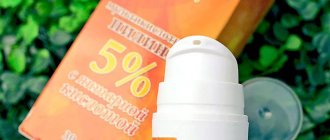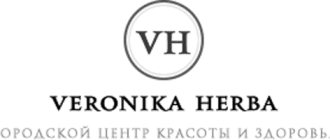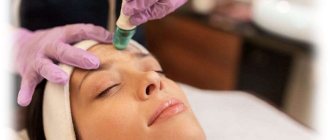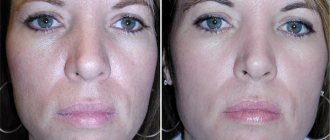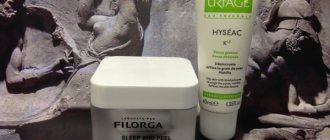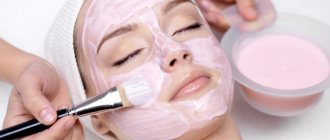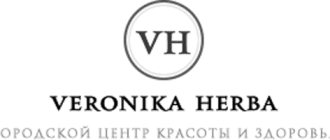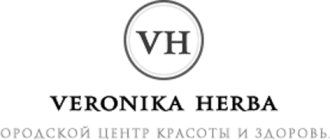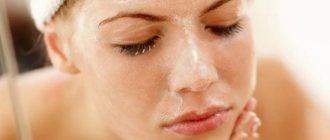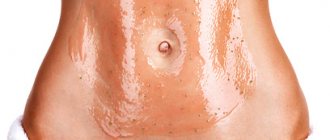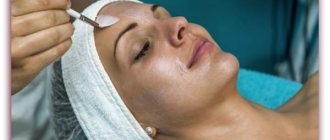Update date: 02/11/2021 10:54:11 49904 Share:
Author of the article: Demidova Anna Viktorovna
*Review of the best according to the editors of simplerule.ru. About the selection criteria. This material is subjective in nature, does not constitute advertising and does not serve as a purchase guide. Before purchasing, consultation with a specialist is required.
Acid peels are specialized preparations for rejuvenating and restorative cosmetic procedures. They are used in beauty salons and at home. Therefore, the experts at simplerule.ru decided to compile for you a rating of the best products that can be bought in a regular or online store. But first, you need to learn more about what acid peels are, what their features are, what types of drugs there are, indications and contraindications for their use.
Glycolic peeling
Glycolic Acid is perhaps the most popular and best known among alpha hydroxy acids.
Firstly, glycolic acid has a small molecule size, it is very tiny - only 76 Daltons, thanks to which it penetrates the skin easily and deeply.
Secondly, glycolic peels have a wide spectrum of action:
- even out the relief, make the skin smooth,
- stimulate the synthesis of collagen and hyaluronic acid, which helps increase skin elasticity and smooth out wrinkles,
- reduce sebum secretion,
- help cleanse pores and eliminate blackheads.
Thanks to such versatile properties, peelings with glycolic acid can be used to solve aesthetic problems of both aged and young skin.
However... Despite their wonderful properties, glycolic peels are not suitable for everyone. For those with sensitive skin with rosacea and couperose, glycolic acid can cause severe redness, prolonged inflammation and excessive flaking.
As a result, instead of the listed positive effects, owners of such skin may experience persistent redness, dehydration, hypersensitivity and more pronounced rosacea.
Therefore, I advise such people to pay attention to the following two acids.
Rating of chemical peels, the cost of which is more than 11,000 rubles
Omorovicza Blue diamond resurfacing peel cleansing Blue Diamond
Peeling product in the form of a scrub is intended for sensitive skin. Thanks to lactic, fruit acids and glycerin, the epidermis has a whitening and cleansing effect. To combat flaking, the composition includes mineral granules. The complex of extracts and shea butter also have a beneficial effect on the appearance of the skin. It is recommended to use 2 times a week. Application area: face and neck. Also contains diamond dust.
A 50 gram jar costs more than 15,000 rubles.
Omorovicza Blue diamond resurfacing peel cleansing Blue Diamond
Advantages:
- Natural.
Flaws:
- Doesn't achieve all the stated effects.
SFERANGS Clearing AHA Peel
Anti-aging professional product from a Korean cosmetics manufacturer suitable for all skin types. The glycolic, lactic, salicylic and fruit acids included in the composition cleanse and restore the skin, helping to narrow pores. As a result, wrinkles are smoothed out and complexion improves.
Aloe vera extract is used as additional ingredients.
Designed to care for the face, neck and décolleté area. Recommended to use a couple of times a week. The jar has a volume of 30 ml and costs about 14,300 rubles.
SFERANGS Clearing AHA Peel
Advantages:
- Effective;
- Suitable for all skin types.
Flaws:
- Not detected.
Milk peeling
Lactic acid specializes in hydration. You can often find it in cosmetics.
Lactic acid is also present in our skin; it is part of the natural moisturizing factor (NMF), and as soon as its amount in the skin decreases, dryness appears.
In low concentrations, lactic acid has a moisturizing, soothing and anti-inflammatory effect. Peels with lactic acid provide a light brightening effect and have a mild exfoliating and stimulating effect.
Such peels increase skin turgor, improve complexion, and can be recommended for owners of thin, dry, dehydrated skin and sensitive skin, including skin with rosacea and rosacea.
Milk peelings are considered soft, even for summer, or rather year-round, so they can be used during periods of sunny activity and are suitable for those who live in hot countries.
Light milk peels can be used to prepare the skin for harsher formulations.
Over the past decades, interest has sharply increased and the range of acid peels used in cosmetology practice has expanded.
The composition of these peels mainly includes hydroxyacids (HA), known in wide practice as both fruit acids and non-fruit acids. Fruit acids include alpha hydroxy acids, or abbreviated AHA acids (glycolic, lactic, malic, tartaric, citric), beta hydroxy acids BHA (salicylic acid), polyhydroxy acids PHA (gluconic and gluconolactonic), and bionic acids BA ( lactobionic, maltobionic, cellobionic), as well as phytic, succinic, azelaic acids. This interest is associated with the unique properties and capabilities of acid peels in solving aesthetic skin problems.
Characteristics of hydroxy acids
Let's consider the effects of AHA acids on the skin. Fruit acids got their name due to their content in fruits, and the chemical name - alpha hydroxy acids - due to the hydroxyl group located in the alpha position of organic carboxylic acids. In the body, fruit acids take an active part in metabolism, being metabolites of many chemical reactions.
Spectrum of biological activity of AHA acids
The effects of AHA peels are more gentle and depend on the acid pH concentration and molecular weight.
The exfoliating exfoliating effect of AHA acids is associated with their effect on corneocytes and the ability to weaken their cohesion with horny scales in response to increased peeling of the skin and through increased loss of transepidermal water, stimulating the activation of basal cells and thickening of the proliferative layer of the epidermis.
The moisturizing effect of AHA is associated with the removal of the old stratum corneum, which does not have a natural moisturizing factor (NMF) and creates a moisture deficiency in the skin, since the moisturizing factor of only young keratinocytes is not enough to hydrate the entire stratum corneum of keratinocytes.
After the exfoliation of old corneocytes and the release of young NMF horn cells to the surface, the skin hydration indicator significantly increases. In addition, citric and lactic acids are components of NMF, thereby increasing its functional content in the skin.
One of the effects of AHA acids is to enhance the synthesis of glycosaminoglycans, collagen and the intercellular substance of the dermis, which makes the skin smoother, firmer and more elastic. Fruit acids also have antioxidant properties, protecting the skin from the effects of reactive oxygen species, and can lighten the skin and reduce hyperpigmentation.
Thus, under the influence of acids in the epidermis, the proliferative keratinocyte layer is built up, the stratum corneum is leveled and thinned, and the intercellular dermal matrix is strengthened, thereby thickening the dermis.
Alpha hydroxy acid peels contain the following acids:
- Glycolic acid is the smallest and most popular of the AHA acids, its molecular weight is 76.05 g/mol, and therefore easily penetrates the epidermal barrier. Contained in sugar cane, green grapes, sugar beets, it promotes the production of type 1-3 collagen and is the main component of modern AHA peels, both professional and home.
After a thorough study of the effects of glycolic acid on a living culture of human fibroblasts, scientists made the following conclusions: the depth of penetration of glycolic acid in the epidermis depends not only on its concentration and exposure time, but also on pH.
The lower the pH of the drug, the higher the permeability of glycolic acid and the higher its irritating ability. There is a very close relationship between the pH of glycolic acid and its effect on the rate of renewal of epidermal cells and the degree of skin irritation. At a concentration of 70% pH 3, the acid gives a noticeable stimulating effect, but also a noticeably high degree of skin irritation; if the acid solution is neutralized to pH 7, the stimulating effect becomes insignificant, but the skin irritation becomes noticeably less. The use of this substance in a low concentration - about 20-30% and a pH of 2-3 for a long time leads to increased exfoliation of dead cells. At the same time, the complexion is evened out, and the surface of the skin becomes smoother.
Relationship between glycolic acid pH, cell turnover rate and skin irritation
- Lactic acid - with a molecular weight of 90.08 g/mol is a product of biofermentation of sour milk, sauerkraut, blueberries, apples, tomatoes and other products. The exfoliating and moisturizing ability comes first. But compared to glycolic acid, lactic acid is gentler and can therefore be used on sensitive skin.
Lactic acid has the same properties as all AHA acids. I would like to pay special attention to its moisturizing properties. At the molecular level, it is part of NMF, adjacent to amino acids, urea, pyrrolidone carboxylic acid and other components.
Lactic acid binds and retains moisture, creating a kind of water shell around itself. Moreover, moisture is not only collected, but also correctly redistributed towards the deep, living layers of the skin, which allows you to create the effect of balanced hydration in the epidermis. Another useful property of lactic acid is to enhance the barrier functions of the skin, promoting the production of ceramides, which, together with cholesterol and fatty acids, form a lipid layer, due to which the skin loses less moisture and better resists stress factors and water-saving mechanisms work not only on its surface, but also inside the dermis. The whitening property of lactic acid is based on both its exfoliating ability and the effect of lactic acid on blocking tyrosinase, which is responsible for skin melanogenesis. The antibacterial properties of the acid are based on the acidifying effect, as well as special laction particles, which slow down the development of many microorganisms.
Photo 5. Therapy for skin photoaging, woman, 62 years old: a - right hand after 6 months of using placebo lotion; b — left hand after 6 months of using lotion with 25% lactic acid (the skin is denser and more elastic, the number of age spots has decreased)
- Malic acid (malonic, hydroxysuccinic acid) - molecular weight 134.1 g/mol, isolated from the pulp of unripe apples and tomatoes, grapes, gooseberries, rhubarb, rowan fruits, barberries, raspberries. In general, apple peeling is a special case of fruit peeling, in which the concentration of malic acid among other fruit acids is 10-15%.
At the same time, malic acid peeling is not only characterized by moderate results in smoothing out deep wrinkles and scars, but also effectively helps in polishing and evening out the complexion and increasing firmness and elasticity, as it actively stimulates cellular metabolism.
- Tartaric acid (tartaric acid) , molecular weight 150.087 g/mol. The main sources of tartaric acid include dried wine yeast and tartar, which forms on the walls of the vessel during wine fermentation. Tartaric acid is a strong antioxidant and biostimulant. Being part of any cosmetic product, it has an exfoliating and moisturizing effect.
The result of acne treatment with a combined course of booster peels: a - before treatment; b - after. When carrying out peeling after applying glycolic acid to the skin, a composition containing 20% mandelic and 10% citric acids was additionally used
- Citric acid is found in citrus fruits (lemon, lime, grapefruit, orange). It has the highest molecular weight of the AHA acids described above - 192.12 g/mol. It has a whitening effect on the skin, which is enhanced in the presence of tartaric acid. Has antioxidant and bactericidal properties.
- Mandelic acid is obtained by hydrolysis from bitter almonds. The large molecular weight of this acid promotes slow diffusion into the epidermis and makes almond peeling very gentle, suitable for patients with various skin types, including sensitive ones. By gently loosening the superficial stratum corneum, this peeling has a delicate exfoliating effect that evens out and brightens skin tone. The lifting effect is due to the production of collagen and elastin, due to this, cellular renewal is activated and shallow wrinkles are smoothed out. Almond peeling can be used in the summer, as the risk of developing hyperpigmentation after the procedure is minimal. Having a structural similarity to macrolide antibiotics, it suppresses the proliferation of pathogenic skin flora and thereby reduces the risk of infection and skin inflammation.
Mandelic acid is capable of binding heavy metal salts, having powerful antioxidant properties. Improves inflamed acne by clearing and removing blockages in the sebaceous gland ducts, thereby reducing and tightening pores and removing black comedones.
- Salicylic acid is a beta-hydroxy acid because its hydroxyl group is bonded to the carbon atom in the β position (next to α in the hydrocarbon chain) and is fat soluble. Salicylic peeling has been used in cosmetology for a long time, but has not yet lost its popularity. Possessing high penetrating ability and a keratolytic effect, this beta acid causes active peeling at the mouth of the hair follicle, which prevents the formation of comedones.
Salicylic peeling, depending on the concentration and pH, can be superficial or mid-superficial. Superficial salicylic peeling is used for problematic oily skin and acne. The concentration of salicylic acid in this case is 15-20%, and the pH is from 2 to 3.5.
When using salicylic peeling with higher concentrations and low pH, deeper peeling occurs. By exfoliating the entire stratum corneum and the top of the proliferative keratinocyte layer of the epidermis, salicylic acid not only stimulates the active production of collagen and elastin, but also leads to active stimulation of basal cells and renewal of the epidermis. Therefore, this beta acid is widely used in the fight against aging skin and other signs of aging, such as rough, rough skin. After the procedure, the skin is tightened, smoothed, sagging is eliminated, and the appearance noticeably improves. In addition to the rejuvenating effect, salicylic peeling has a keratolytic effect, which significantly improves the condition of oily skin prone to acne. The lightening effect is associated with a pronounced exfoliating effect, in which horn cells with spent melanin are removed. Salicylic peeling has many advantages, such as easy implementation and controllability of the procedure, the possibility of carrying out the procedure at any age, as it is suitable for patients with a high level of skin photoaging, can be used both on the face and on any part of the body, applicable to all four skin phototypes, minimal number of contraindications. Salicylic acid, which is quite harsh and aggressive in itself, is rarely used in its pure form; to soften it, fruit acids are added to the peeling composition.
- Pyruvic acid is the second lipophilic acid in modern peels. Pyruvic acid (PKP) is α-ketopropionic acid, or pyruvate, an organic keto acid that has the properties of carboxylic acids and ketones, and is also the end product of the glycolytic breakdown of glucose. Pyruvic peeling is obtained from tartaric and lactic acids. It has a sharp, unpleasant odor, but does not cause allergies, since it has a similar composition to skin and is completely recycled in human tissue. PVK is found in all tissues of the body and takes part in many biological processes. Low molecular weight - 88.06 g/mol - combined with lipophilicity gives PVC a high penetrating ability, more than glycolic, but controlled like trichloroacetic acid. When it comes into contact with the skin, PVC is hydrolyzed and converted into lactic acid, which is part of the skin's moisturizing factor and provides good hydration to the skin.
Therefore, PVC is used in the correction of the following aesthetic problems: seborrheic dermatitis, rosacea, hyperpigmentation, photoaging, dermal atony, dark circles under the eyes.
Acids used in later cosmetology practice
- Azelaic acid (nonanedioic acid) is a dibasic saturated carboxylic acid that has all the chemical properties characteristic of carboxylic acids. It is obtained by ozonolysis or oxidation of oleic or linoleic acid. It has pronounced antioxidant properties, models the processes of keratinization in the sebaceous glands with closed comedones and seborrheic dermatitis.
Inhibits the action of 5-α-reductase, reduces sebum production, normalizes the process of sebum formation, thereby preventing the appearance of black comedones. It has an antimicrobial effect on opportunistic skin saprophytes Propionibacterium acnes and Staphyloccocus epidermidis. The whitening effect of azelaic acid is similar to hydroquinone, which is achieved by inhibiting the enzyme tyrosinase, and also inhibits the synthesis of DNA and RNA of melanocytes, slowing down the proliferation of keratinocytes.
Azelaine peeling
Azelaine peeling is a superficial peeling and is used to solve dermatological problems: demodicosis, acne and post-acne, ingrown hairs, hyperpigmentation, rosacea, folliculitis, rosacea, melasma, seborrheic dermatitis, etc.
In addition to azelaic acid, manufacturers often add lactic, citric, glycolic, salicylic and almond acid to this peeling, which, depending on the proportions and concentration, eliminate varying degrees of severity of skin diseases.
The main active component of the peeling preparation in this case is azelaic acid with a concentration of 15-30% and pH 1.8-1.3. Azelaine peeling is easily tolerated, has a mild irritating effect on superficial tissues, and does not require a long recovery period.
- Phytic acid , or myo-inositol hexaphosphoric acid, is found naturally in cereal seeds, legumes, some vegetables, and also in oilseeds. Due to its high molecular weight of 660.04 g/mol, even at a high concentration of 50% and a low pH of 1.2, it does not cause damage to the deep epidermal layers. It has been proven that phytic acid, along with a deep and very gentle cleansing and exfoliating effect, has the ability to inactivate the enzyme tyrosinase, the excessive production of which leads to hyperpigmentation. This determines the high antioxidant, lightening and anti-inflammatory properties of phytic acid, which contribute not only to the effective prevention of the appearance of age spots, but also to the rapid elimination of existing ones. Along with this, phytic acid has a good rejuvenating and lifting effect, narrows enlarged pores, fights keratomas and rosacea.
Phytin peeling
Phytin peeling is superficial. Its implementation does not require neutralization. In addition to phytic acid, peeling compositions often include a high percentage of glycolic or tartaric acid. Experts classify phytin peeling as an all-season peel and recommend using it even during periods of high solar activity.
Polyhydroacid peeling
- Polyhydroacid peel with gluconolactone, or D-gluconic acid δ-lactone, is an ester with a cyclic structure.
Gluconolactone is found naturally in honey, wine, corn, some fruits and tea. Its action is similar to that of α-hydroxy acids, but the properties of polyhydroxy acids have significant differences. Being an AHA acid with five hydroxyl groups in the molecule, it has more pronounced moisturizing properties. The absence of a carboxyl group in the ether form of the molecule helps eliminate the irritating effect on tissue. Thanks to its high molecular weight, this peel slowly penetrates the epidermis, thereby not causing a pinching effect on the skin, and is therefore recommended for the most sensitive skin. Gluconolactone is a natural antioxidant, comparable to vitamins A and E, capable of blocking processes that activate the synthesis of interleukin-1 to suppress inflammatory reactions in the skin. Gluconolactone modulates skin pH, which helps restore the acid mantle of the epidermal barrier also by activating lipid synthesis in keratinocytes. An important mechanism promoting hydration is the ability of gluconolactone to transport water molecules, thereby stimulating the lipid synthesizing activity of keratinocytes through a decrease in the concentration of calcium ions. The brightening property of gluconolactone is associated with the ability to form chelate complexes with metals and remove free radicals. The latter may be iron, contained in skin cells and causing natural oxidation processes. Excess iron, combined with exposure to ultraviolet radiation, causes more pronounced pigmentation - a typical sign of bio- and photoaging.
Gluconolactone initiates both the synthesis of the dermal matrix of the skin, elastin and collagen, and the production of the ground substance of the dermis
- hyaluronic acid. Its keratolytic effect leads to an even skin tone.
- Bionic acids belong to another group of polyhydroxy acids. The leader in cosmetology practice is Lactobionic acid, or 4-O-β-galactopyranosyl-D-gluconic acid. It consists of gluconic acid and galactose connected by an ester bond, formed due to the oxidation of milk sugar.
The stabilizing properties of lactobionic acid are associated with the ability to synthesize chelate compounds with metals of variable valence, including iron.
Being, like gluconolactone, a substance with a large molecular weight, it slowly penetrates the skin and does not cause an irritating effect, does not provoke excessive peeling, hyperemia and itching of the face. Galactose, which is part of lactobionic acid, promotes rapid recovery and rapid regeneration of damaged skin structures. Therefore, lactobione peeling can be used for active recovery after traumatic procedures such as laser resurfacing, plastic surgery, deep peelings, microdermabrasion.
And the property of this acid to inhibit matrix metalloproteases, when activated, destroys the main components of the dermal matrix, helps combat photoaging. After application to the surface of the skin, lactobionic acid creates an aqueous film, which for a long time prevents the skin from drying out and the development of an unpleasant feeling of itching and tightness. The gentle exfoliating effect allows you to use this peeling during the work week. And powerful photoprotective properties allow you to use lactobionic acid along with mandelic acid in the summer, without fear of the appearance of age spots.
- Succinic, or butadionic acid (mineral organic resin) is another amazing substance that is extracted from certain plants and amber. It is also synthesized in the human body and does not have the aggressive properties of other chemical compounds. Butadionic acid strengthens capillary walls, improving microcirculation. It improves cellular respiration processes and is capable of restoring and rejuvenating aging tissues, has a mild effect and is used in the treatment of rosacea, hyperpigmentation, hyperkeratosis, and dermal atony.
Conclusion
Typically, professional peelings include not one acid, but several, a so-called cocktail, which allows you to potentiate the positive effect and deactivate the negative effect on the skin. And we should not forget that the deeper the peeling affects, the more pronounced the effect on the skin it has, but the risk of complications such as pigmentation, herpes, inflammatory processes, and the formation of secondary dryness due to the appearance of a keratohyalin film increases.
Therefore, in order to achieve maximum effect, it is equally important to pay great attention to the further rehabilitation period at home, using creams that can quickly restore the epidermal barrier of the skin, and these creams should contain a minimum content of synthetic chemical components.
Natalya Skurikhina, biochemist, dermatocosmetologist, developer of peelings and cosmeceuticals SuNViPeel, cosmetic line Vinas, technologist of natural cosmetics Organic AllSkin, member of the association of doctors KALDAT (South Korea), head of the “School of Peels”, Almaty
Almond peeling
Mandelic Acid has a large molecule, does not increase skin sensitivity to the sun and can be used at any time of the year, of course with precautions - be sure to use a cream with a high SPF, do not sunbathe, etc.
Almond peeling is considered the most gentle of superficial peels, so it can be used even for thin, sensitive skin prone to rosacea.
This peeling can be prescribed from the age of 14 for the treatment of teenage acne. In adulthood, it is used as a superficial peeling for sensitive or oily skin, as well as to smooth the skin in preparation for more aggressive formulations.
Mandelic acid normalizes sebum secretion, has a pigment-constricting effect, eliminates comedones, evens out complexion, so these peels will be effective if you have:
- increased sebum secretion,
- enlarged pores,
- clogged pores (comedones, blackheads),
- superficial pigmentation,
- sensitive aging skin.
Salicylic peeling
Salicylic Acid specializes in oily and problematic skin.
It has a pronounced exfoliating effect, and problem skin is characterized by an increased formation of keratinized scales. The scales can stick together and close the ducts of the sebaceous glands, thereby creating favorable conditions for clogged pores and the appearance of acne.
Salicylic acid successfully dissolves sebaceous plugs, reduces sebum secretion and normalizes sebum composition, which is extremely important because acne-prone skin is characterized by viscosity and increased sebum production.
In addition, salicylic acid has an antimicrobial effect and helps lighten post-acne pigment spots.
Accordingly, the main indications for the use of peels and products with salicylic acid:
- increased sebum secretion,
- uneven terrain,
- pore blockage,
- black dots,
- age spots and post-acne scars.
However, salicylic acid can be irritating and cause redness, so people with sensitive skin should proceed with caution - use milder products and opt for other peels.
What factors influence the ranking?
When compiling a rating and distributing the places that certain acid peels occupy in it, our experts take into account the following aspects:
- Type of peeling. We have tried to select medications for you that are as safe as possible to use at home.
- Release form, ease of use of the drug.
- The relationship between the cost of peeling and its effectiveness.
- Opinions of women who have already used a specific cosmetic product.
- The point of view of dermatologists and qualified cosmetologists.
The rating of acid peels compiled by our experts will help you save time when choosing a product and buy a product that will meet your expectations.
Jessner Peel (Hollywood)
Another one of the most famous peelings. It is often called Hollywood because of its popularity among the stars.
The classic Jessner peeling formula is a water-alcohol base and a mixture of three components:
- Resorcinol,
- Lactic acid
- Salicylic acid
Jessner peeling has a wide spectrum of action, so it can be used to correct age-related changes and improve the condition of problem skin.
The depth of peeling penetration depends on the number of layers, due to which you can achieve different results - both a superficial effect with slight peeling, and a deeper effect with pronounced peeling.
Therefore, indications for such peeling can be very different:
- enlarged pores,
- increased sebum secretion,
- uneven terrain,
- expression wrinkles,
- acne spots and scars.
Azelaine peeling
Azelaic Acid specializes in the treatment of skin with acne and rosacea. It inhibits 5-alpha reductase and tyrosinase, thereby reducing sebum secretion and lightening post-acne spots.
In addition, azelaic acid has an anti-inflammatory, antimicrobial effect and normalizes the keratinization process, that is, it effectively fights pore clogging.
At the same time, azelaic acid has a gentle effect, so it can be used even for sensitive skin with rosacea. But chemical peels with this acid may also contain other acids, so they must be selected individually.
But in general, I advise people with sensitive skin, acne, post-acne, rosacea and rosacea to take note of this acid. Moreover, it is an acid that can also be used during periods of active sun.
Types of peelings by depth of exposure and their effect ↑
Chemical peels are traditionally classified by depth of effect. The higher the pH and concentration of active substances in the peeling, the deeper it penetrates into the tissue.
Superficial peeling
Acts on the top layer of skin. With proper post-procedural care, it does not require a long recovery period. It is considered the softest, because the concentration of acids in superficial peels does not exceed 20%. They are used to improve skin color, restore freshness, restore radiance, and mattify the effect.
Superficial-medium peeling
Preparations for superficial-medium peeling contain acids in higher concentrations than in superficial peeling. This ensures deeper penetration of the active ingredients into the skin. Peeling of this type has a rejuvenating, smoothing, brightening effect, and also normalizes the functioning of the sebaceous glands.
Medium peeling
Affects the epidermis without affecting the basement membrane. Effectively eliminates shallow wrinkles, post-acne and other aesthetic imperfections of the skin, and also fights age-related changes. After such peeling, redness, swelling, and peeling appear on the face, and therefore the rehabilitation period increases to 7 days.
TCA peeling
Trichloracetic Acid, or TCA for short, has a pronounced keratolytic effect. TCA causes protein coagulation and removal of the upper layers of the epidermis. At the same time, TCA stimulates fibroblasts and activates the synthesis of dermal structures - collagen, elastin, hyaluronic acid.
The main indications for TCA peeling are post-acne scars, hyperkeratosis, pronounced wrinkles, and decreased skin tone.
You often ask my opinion on how I feel about this or that peeling, for example, TCA. There is no bad or good peeling. The result depends on what is prescribed, to whom and for what purpose.
A good example was in the comments to the last video. The girl wrote: “I do TCA every year, 45 years old, Asian skin is porous, thick, other peels are ineffective for me.”
It is quite possible that if the skin is thick and resistant, soft peelings will be like grain to an elephant, but the skin will tolerate TCA normally. But for people with sensitive skin, I would not recommend this peeling, because it is a rather harsh peeling.
Thin, sensitive skin will take a long time to recover, which can lead to complications in the form of post-inflammatory pigmentation.
PRX-T33
I think the same about the PRX-T33 peel, which you often ask about. It was widely advertised last winter and was positioned as universal, suitable for all skin types, including sensitive ones.
Because this formula uses a hybrid molecule of TCA and hydrogen peroxide, which prevents the damage of protein denaturation.
The upper layer of the epidermis does not suffer as much as with TSA, and the rehabilitation period is more comfortable.
But still, this peeling contains 33% trichloroacetic acid and 5% kojic acid, which also has a pronounced irritating effect.
TCA easily penetrates into the deeper layers of the skin, the depth of exposure is difficult to control, and sensitive skin is already more permeable.
Last year I consulted with several girls with thin, sensitive skin who asked for help to restore their skin after PRX-T33. Because it took a long time for the skin to recover after peeling, and the cosmetologists who performed the procedure said: “This means this peeling is not suitable, and the redness and hypersensitivity will go away over time.”
But it's not right. The skin needs to be helped to recover in time, otherwise prolonged inflammation can lead to side effects, for example, post-inflammatory pigmentation, which will then be very difficult to get rid of.
Therefore, if you have indications for TCA peeling, but have sensitive skin, it is better to pay attention to pyruvate peeling, which is based on pyruvic acid.
Acid peeling – what is it and what is it for?
Acid peeling is used to deeply cleanse the skin. Since the lifespan of dermal cells is 28 days, after this time they die, but remain on the surface of the face, clogging pores, causing the development of inflammatory processes, stimulating the aging process of the epidermis. Clogged and dirty pores do not allow the skin to breathe freely and receive sufficient nutrients from external sources. And this is where acid peeling comes to the rescue, which will help quickly and effectively remove the dead layer of cells and cleanse not only on a superficial level, but also on a deeper level. The use of such products allows you to prolong the health, youth and beauty of your facial skin.
How acid peeling works:
- Exfoliation of the top layer of the skin, followed by renewal of the epidermis.
- Penetration into the deep layers of the dermis with the deliberate application of light burns, which act on the epidermis as a stress factor. Such traumatization of the skin causes accelerated renewal of the skin, starting the processes of self-healing and regeneration. The body, in order to restore damaged tissue, begins to more actively produce elastic proteins that are responsible for maintaining the tone and turgor of the dermis - collagen and elastin.
As a result of using acid peeling, you can get the following effect:
- Effectively cleanses the skin, narrowing pores, making them less noticeable.
- Normalization of the microrelief of the facial surface, as well as the shade of the epidermis. Dullness, dullness, hyperpigmentation, gray, yellow or greenish tones disappear.
- Restores skin elasticity, disappears fine wrinkles, reduces the severity of large folds.
- Normalization of metabolic processes and hydro-lipid balance.
If you plan to perform acid peeling on a girl under 20 years of age who has not yet seen visible age-related changes, it is recommended to use a product based on fruit acids. This cosmetic product has a gentle effect on the epidermis, while at the same time effectively preventing the earlier occurrence of manifestations of the aging process.
If a woman aged 30-35 years and older who wants to get a pronounced rejuvenation effect is going to undergo acid peeling, it is recommended to use a drug based on chemicals. The type of acids, the required concentration, the number of procedures - all this should be determined by a specialist, based on the specifics of the aesthetic problem, indications, age and initial condition of the woman’s skin. That is why, even if you plan to carry out cleansing procedures with acid peelings yourself, it is recommended to first consult with a cosmetologist.
Acid peels are made on the basis of different acids, which have certain characteristics and have different effects on the skin. Therefore, before buying a cosmetic product, read its composition.
Ferul peeling
Ferulic Acid has a pronounced antioxidant effect.
It suppresses the activity of free radicals, inhibits the activity of tyrosinase, and also improves skin firmness and elasticity. And thanks to these properties, it is recommended for the prevention of photoaging and skin pigmentation disorders.
Ferulic acid is gentle and therefore suitable for sensitive skin. By the way, I’m currently giving myself a course of ferul peeling.
True, my peeling is multi-acid and, in addition to ferulic acid, contains malic, citric, lactic acid and retinol. Therefore, it has a wider spectrum of action and can be used not only independently, but also as a preparation for retinoic peels.
Rating of the best acid peels
| Nomination | Place | Name of product | Price |
| Rating of the best acid peels | 1 | Natura Siberica with AHA/BHA Wild berries acids | 338 ₽ |
| 2 | Azelique Age Refining Activated Charcoal & Clay Mask, with Azelaic Acid | 1 266 ₽ | |
| 3 | Natural facial peeling gel Planeta Organica | 709 ₽ | |
| 4 | Ecco Bella Leave-On Invisible Exfoliant & Blemish Remedy | 2 596 ₽ | |
| 5 | Mizon AHA 8% Peeling Serum | 1 655 ₽ | |
| 6 | Pixi Beauty Glow Peel Pads | 2 840 ₽ | |
| 7 | Cotton swabs impregnated with A'pieu AHA & BHA Aqua Peeling Cotton Swab | 80 ₽ |
Whitening peeling Natura Siberica with acids AHA/BHA Wild berries
Rating: 4.9
This acid peeling takes first place in our rating, as it has an impressive composition. The formula of the drug contains lactic, glycolic and salicylic acids, which have a complex effect on the skin. Among the components of the product there are also panthenol, various vegetable oils and extracts that promote the fastest possible restoration of the skin.
Reviews from women who have used the peeling say that it has a dense, slightly viscous, creamy consistency that is completely imperceptible on the skin with barely noticeable particles. The product does not dry out on the face, does not cause a feeling of tightness or burning, and is easily washed off without leaving a residue.
It is recommended to use acid peeling from the Natura Siberika brand 2 times a week for 5-7 minutes. The result is a feeling of renewed, incredibly smooth and soft skin. As well as a natural, uniform complexion, improvement in the condition of the dermis, which has traces of inflammation.
Advantages
- Reliable domestic manufacturer.
- Reasonable price.
- Excellent safe composition.
- Fast action.
- Pleasant consistency.
- Unobtrusive scent with notes of raspberries and other berries.
- Excellent effect with slight lightening of the skin.
Flaws
- If you leave the cream on your face for too long, persistent redness will occur.
Azelique Age Refining Activated Charcoal & Clay Mask, with Azelaic Acid
Rating: 4.8
The next position in our rating is occupied by a relatively expensive, but undoubtedly high-quality peeling in the form of a mask. The drug has a versatile effect and can improve the condition of both problematic and aging skin of any type. The product contains acids - glycolic and azelaic. As well as a set of other components useful for the epidermis. These are activated carbon and dirt-absorbing clay. And algae, hyaluronic acid, which increases moisture levels. There are extracts from plants - green tea, cucumber, aloe.
According to user reviews, using an acid peeling mask is easy and comfortable. After drying, the drug causes a slight feeling of tightness and tingling, and is washed off without problems. Scrubbing particles additionally carefully cleanse the surface of the face when washing and have an exfoliating effect. As a result, the skin after the mask becomes matte, velvety, smooth and toned, and blackheads and pores are almost invisible on the face.
Advantages
- Great composition.
- Comfort of use.
- Complex effect.
- Versatility, can be used for any skin type.
- Skin healing.
- Additional exfoliating effect.
Flaws
- Relatively high price for 140 milliliters of product.
- When used on sensitive skin, an unpleasant burning sensation may occur.
Natural facial peeling gel Planeta Organica
Rating: 4.7
The next position in our ranking is occupied by gel peeling, suitable for all skin types, even dry and sensitive. The product is convenient to use, as it comes in the form of a spray can. Acid peeling is considered a budget product, but it contains expensive AHA acids. As well as papaya extract and enzyme, apple fiber, citric, lactic acid, pineapple enzyme, extracts of bhringraj, echinacea, sugar cane, licorice, lemon, rosemary. And oils - carrot seeds, macadamia, avocado, grape seed, guaiac wood, lime, olive, neem tree. And vitamins F, A.
If you read user reviews, you will find out that the product is applied for 10-15 minutes, does not dry out, and is easily washed off with water the first time. While using an acid peel, a burning sensation may occur, but it quickly passes. After washing off the product, there is no redness, the skin becomes soft and smooth.
Advantages
- Very rich composition.
- Low price.
- Convenient release form.
- Easy and safe to use on any skin type.
Flaws
- Small volume - only 50 milliliters.
- To get noticeable results, peeling must be used regularly for at least a month.
Ecco Bella Leave-On Invisible Exfoliant & Blemish Remedy
Rating: 4.7
The next step up in our ranking is a clear, leave-in cleanser for cleansing skin and removing blemishes. The drug is distinguished by the fact that it contains a rare combination of AHA and BHA acids. Also included in the peeling components are clay, oat extracts, calendula, licorice, vitamins E, C. And essential oils of lavender, rosemary, and pelargonium.
According to reviews from women, the result of peeling is noticeable after the first use. The face looks fresh, the color is even, the texture improves, the pores are narrowed. If inflammation occurs on the skin, it goes away very quickly, almost within a few hours. The product can be applied to the skin every day (before bedtime), there is no need to rinse off.
Advantages
- Balanced composition.
- An excellent result that lives up to expectations.
- Possibility to use every day and not wash off.
- Economical consumption - the product lasts for 3-5 months of regular use.
Flaws
- Acid peeling is available in the form of a heavy glass bottle without a dispenser. To get the gel, you need to literally “shake it out” by turning the bottle upside down.
- During use, the skin feels sticky.
- High price.
Mizon AHA 8% Peeling Serum
Rating: 4.7
This Korean-made drug occupies a place in our rating because, despite the rather high price, it contains as much as 8% glycolic acid. This is considered an excellent indicator for drugs that are intended for independent, home use. The peeling also contains preparations that promote rapid restoration of the skin after the procedure - oils and fruit extracts.
According to user reviews, it is convenient to use the drug, which is facilitated by a bottle with a pipette and a button dispenser. The consistency of acid peeling is similar to water. Distributes easily and evenly over the face. The result after the first use is that the skin becomes smooth, the texture is evened out, wrinkles disappear, as do peeling and oily shine. The complexion is evened out, becomes more natural, spots are lightened.
Advantages
- The product is suitable for normalizing the condition of the “thickest” skin, which is less susceptible to the effects of other drugs.
- Good composition.
- Convenient release form.
- Optimal consistency.
- The ability of peeling to increase the moisture content of the skin.
Flaws
- The bottle is opaque, it is quite difficult to assess how much liquid is left in it.
- The product leaves a sticky feeling on the skin.
- Peeling has a sharp sour smell.
- Doesn't cope well with acne and blackheads.
- High price for a 40 ml bottle.
Pixi Beauty Glow Peel Pads
Rating: 4.6
This place in our rating is occupied by an unusual acid peeling, which is available in the form of discs impregnated with a cosmetic preparation. The discs are in a plastic jar with a tight-fitting lid, so they do not dry out between uses.
The peeling contains a large amount of glycolic acid - 20%, lactic and salicylic acid. As well as additional components - retinyl palmitate, extracts of various plants.
According to user reviews, wiping the skin with impregnated cotton pads is convenient, nothing leaks, there is no burning sensation, as well as a feeling of tightness or irritation of the skin. One disc is enough to treat not only the face, but also the décolleté area. The drug is easily washed off with water 3-5 minutes after application.
The result of peeling is smooth, radiant, soft skin with a smoothed texture and narrowed pores. And also a more even complexion, lightening of pigmentation and post-acne, reducing the number of blackheads, pimples, and comedones.
Advantages
- Impregnated discs are one of the most convenient forms of release.
- Economical to use - 60 discs are enough to use the product every day for 2 months.
- Good composition.
- Comfort of use without burning sensation.
- Occurrence of the expected result after the first application.
Flaws
- At first, the discs seem a bit dry and not well soaked.
Cotton swabs impregnated with A'pieu AHA & BHA Aqua Peeling Cotton Swab
Rating: 4.5
The next position in our rating is occupied by an unusual product - cotton swabs soaked in acid peeling. Our experts gave this drug last place solely because it is expensive. The effectiveness of the product is high and reviews about it are 95% positive.
There are three types of impregnated cotton swabs – MILD (5% AHA+10% Lime); INTENSIVE (8%AHA + 10% Aloe); Two Step Black Head Swab. The first is suitable for delicate and sensitive skin, the second is for those who want to get a pronounced result, the third is a combination of acid peeling and a patch for blackheads.
According to user reviews, using acid peeling, which is impregnated with the tips of the sticks, is very easy. It is enough to remove the individual packaging, rub cotton wool over your face, wait 10 seconds until the drug dries, and the procedure is completed. The quality of impregnation allows you to apply not one, but two or even four layers of the product at a time, increasing the effectiveness of the drug.
Advantages
- A very convenient release format - disposable sticks are completely ready for use.
- Light aroma.
- High efficiency - smoother and more even skin, healthy complexion.
- Several impregnation options with varying degrees of peeling effect.
- There is no need to rinse off the product; you can immediately apply decorative cosmetics.
Retinoic or yellow peeling
Retinoic acid (Retinoic Acid, Retinol, Retinaldehyde) has a fairly wide spectrum of action:
- accelerates the renewal of epidermal cells,
- eliminates pigmentation,
- stimulates the synthesis of collagen and hyaluronic acid,
- prevents the appearance of wrinkles and reduces the severity of existing ones,
- normalizes sebum secretion.
Retinoic acid can be used to solve skin problems with acne, and to correct various age-related changes, and to combat pigmentation disorders.
However, retinoic peels almost inevitably cause side effects called retinoid dermatitis. Therefore, you need to be prepared for redness, itching, swelling and increased sensitivity of the skin after yellow peeling.
In addition, retinoic peeling requires preparation.
Firstly, in order to even out the surface of the skin and improve the penetration of retinol. And secondly, so that the skin adapts to retinol and the inevitable side effects are not so pronounced.
Which peeling to choose
Another frequent and typical question that I receive in the comments: - I’m 48 years old, I have combination skin, can you recommend what kind of peeling to do?
Too little information. It is impossible to give specific recommendations on chemical peels without seeing you.
To recommend a specific peel, you need to consider:
- Skin condition
- Sensitivity
- Phototype
- Problems that you want to eliminate - pigmentation, wrinkles, post-acne
- Individual tolerance
- Rehabilitation period - there is an opportunity to stay at home
- Your capabilities - how many procedures you can do
- Climate and other nuances
You need to understand that to achieve maximum results, the course may include several different peels. And even a combination of peelings during one procedure.
Not only acid matters, but also:
- concentration,
- pH,
- number of layers,
- what other ingredients are included in the peeling,
- preparation, post-peeling care, etc.
There are many nuances. As you understand, this is a task for an experienced cosmetologist, and requires an individual approach. You are 48, have combination skin, I am 48, also have combination skin, and our peels can be completely different.
But I can give one universal piece of advice to everyone in absentia.
Reviews from a cosmetologist
Victoria, 27 years old. Saratov.
Exfoliation of the epidermis with acid peeling is a universal technique. A professional approach, competent calculation of acid concentration and choice of active substance allows you to achieve excellent results. I have been working in a beauty salon for 5 years. Clients of all ages come to me. Even I am still impressed with the result. Especially if I then compare the photo before the procedure with the result obtained. Home experiments will never compare with professional acid peeling performed on the face by a specialist. In general, I believe that everyone should do what they know how to do, and you can ruin your skin in a minute. Correcting it later is difficult, and not always possible.
Always start with light superficial peels
First option. You can have a couple of light superficial peels done by a cosmetologist, and based on how the skin reacts and how it recovers after peeling, decide what to do next. Move on to more intense and deep effects or limit yourself to superficial peels.
Second option. Guided by the same principles - taking into account the condition of the skin and the properties of the acids that I talked about today, use peelings for home care.
The concentration of such agents is usually no higher than 10-12%, and the pH is not lower than 3.5.
Such peels are relatively safe, but at the same time quite effective. If your problems cannot be solved with home peelings, such products can serve to prepare the skin for professional peelings from a cosmetologist.
But aggressive hard peelings are not always necessary.
If you do not have serious problems - deep wrinkles, scars, deep-lying pigmentation, or are unable to undergo a course of peelings from a cosmetologist, then you can conduct a course of peelings at home.
During online consultations, if necessary, I select products with acids for home care for clients, and we achieve good results.
With the help of home peelings you can successfully solve minor superficial problems:
- even out skin texture,
- smooth out small wrinkles,
- lighten pigmentation,
- reduce sebum secretion,
- eliminate blackheads,
- reduce enlarged pores.
If you have more serious problems, then with deep exposure the effect will, of course, be greater. But home peelings can also improve the situation.
Contraindications for the use of acid peels, possible side effects
Before starting a cosmetic procedure to renew the skin, read the contraindications:
- Exacerbation of herpetic infections.
- The presence of voluminous neoplasms in the treatment area, for example, papillomas or moles protruding above the surface of the skin.
- The presence of a vascular network on the face.
- Extensive purulent rashes on the face.
- Diseases of the epidermis - dermatitis, psoriasis, eczema, etc.
- The presence of burns or mechanical damage, for example, wounds, scratches or abrasions.
- Oncological diseases (any).
- Kidney, heart failure.
- Tendency to form keloids and scars.
- Increased sensitivity of the skin.
- Very dark, dark skin.
- The presence of an allergy to one or more components of the drug.
- Acid peeling should not be performed within 2-3 weeks after any beauty salon procedures.
- You should use the drug with caution if you have tattoos on your face, as acids can affect pigments and lighten them. During pregnancy and breastfeeding, as well as during menstrual periods, acid peeling is not carried out or is carried out only after mandatory consultation with the attending physician.
- Also, before carrying out the procedure, you need to become familiar with what reactions may occur, which of them are predictable and normal, and which are considered complications.
- Expected skin reaction:
- Moderate redness.
- Development of a mild inflammatory process.
- Increased dryness of the skin.
- Peeling, which is accompanied by the “peeling off” of a thin layer of skin.
- Complications can be considered:
- Tissue infection.
- The occurrence of extensive inflammation.
- Severe redness.
When using superficial acid peels, complications occur extremely rarely, and the expected reaction is mild. Therefore, these drugs should be used at home. Medium and deep peelings are recommended to be used independently only under the supervision of a cosmetologist or in a beauty salon or cosmetology clinic.
